Repeat- Writings on Architecture - Kaddish for a Legendary Adler & Sullivan designed Chicago Church (original) (raw)
“Blessed be He, beyond all the blessings and hymns, praises and consolations that are spoken in the world.” - from the Mourner's Kaddish
Logic and morality both caution us to heed the difference between life and matter. When Mistress Quickly describes death overtaking the body of Sir John Falstaff, she likens it to his turning to stone, describing touching first his feet, and finding that "they were as cold as stone; then I felt to his knees, and they were as cold as any stone, and so upward and upward, and all was as cold as any stone." But in the inverse, outside of Don Giovanni, can stone ever become spirit?
When a fire gutted the Pilgrim Baptist Church last Friday, it seemed only fitting to take solace in the fact that only the building - the fabricated, lifeless thing - that had been destroyed. The important thing was that there was no loss of 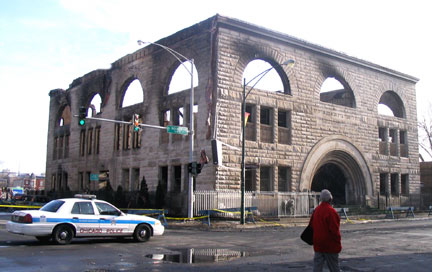 life, no injuries. And yet, there remains a deep sense of loss, not just for Chicago architecture as an aesthetic concern, but for the destruction of a century of collective memories - the Jewish prayers, the joyous gospel music, the ceremonies of loss and trial and celebration - that had been absorbed, year upon year, into the rich, warm wood of the church's oak-clad barrel vault. That was what was lost - an architecture that made the life experience tangible, and passed living emotion down through the generations like a torch.
life, no injuries. And yet, there remains a deep sense of loss, not just for Chicago architecture as an aesthetic concern, but for the destruction of a century of collective memories - the Jewish prayers, the joyous gospel music, the ceremonies of loss and trial and celebration - that had been absorbed, year upon year, into the rich, warm wood of the church's oak-clad barrel vault. That was what was lost - an architecture that made the life experience tangible, and passed living emotion down through the generations like a torch.
For Pilgrim Baptist Church, the times that it captured dated all the way back to 1861, when Abraham Kohn, who would become Dankmar Adler's father-in-law, founded the Kehilath Anshe Ma'ariv (Congregation of the Men of the West), and Adler's father, Liebman Adler, became it's first rabbi. It was at a time when waves of emigrants were causing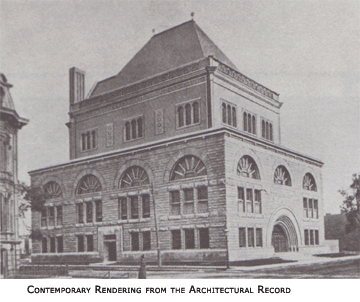 Chicago's population to explode, and by the 1880's the area on Chicago's south side had become a vital center of the city's Jewish community. The thriving congregation turned to Dankmar Adler to design a new synagogue, a decision no doubt influenced by the strong family connections and Adler's faithfulness as a member of the congregation, but also due to his reputation for creating auditoriums - such as the 1886 Auditorium, itself - that were renowned for their superior acoustics. In the bargain, they got Adler's partner and chief designer, Louis Sullivan, and the result was a masterwork, even if flawed and compromised, of ecclesiastical architecture.
Chicago's population to explode, and by the 1880's the area on Chicago's south side had become a vital center of the city's Jewish community. The thriving congregation turned to Dankmar Adler to design a new synagogue, a decision no doubt influenced by the strong family connections and Adler's faithfulness as a member of the congregation, but also due to his reputation for creating auditoriums - such as the 1886 Auditorium, itself - that were renowned for their superior acoustics. In the bargain, they got Adler's partner and chief designer, Louis Sullivan, and the result was a masterwork, even if flawed and compromised, of ecclesiastical architecture.
The design was unlike any other house of worship. "The church spire in the city," said Sullivan, "is a thing of a past." The design looked nothing like a traditional synagogue. Instead, it drew on the brawny, confident Romanesque architecture of Henry Hobbs Richardson, with a pyramided clerestory that reflected Sullivan's 1887 mausoleum for lumber baron Martin Ryerson, which itself derived from the pyramid and mastabas of ancient Egyptian tombs, no small irony for a people whose history in Egypt was one of bondage.
The original design, never executed, was the more lavish and graceful. The walls were have to been entirely of limestone, and the clerestory pyramid was to have risen from a hipped roof that topped  off the square pavilion below. By the time of construction, financial concerns had scaled back the plans at the expense of a unity of design. The main body of the building was faced with a cheaper Joliet limestone, and then only on the major streetfronts along Indiana and 33rd - the other two facings were executed in brick. The hipped roof was gone, the remaining roof covered in red slate. The clerestory was now faced, not with stone, but in metal stamped with ornament. The most striking element of the exterior were the large arched windows and an even larger arch framing the main entrance portal.
off the square pavilion below. By the time of construction, financial concerns had scaled back the plans at the expense of a unity of design. The main body of the building was faced with a cheaper Joliet limestone, and then only on the major streetfronts along Indiana and 33rd - the other two facings were executed in brick. The hipped roof was gone, the remaining roof covered in red slate. The clerestory was now faced, not with stone, but in metal stamped with ornament. The most striking element of the exterior were the large arched windows and an even larger arch framing the main entrance portal.
“The upper portion, which is of copper, according to competent architects ought to be of stone”, an 1890 article in the Chicago Tribune noted derisively. “But this is not the fault of the architect. The congregation, through the building committee, wouldn't have it.” In the same article, Sullivan rather defensively argued for the structure's logic. “It is the nineteen century school,” said Sullivan. “That is all I can say for it. It has no historical style. It is the present. We have got to get away from schools in architecture. As long as we adhere to schools of anything there is no progress; nothing gained, no advancement. What school does that represent? None.”
There was less controversy about the Temple's interior, which was universally regarded as a triumph. 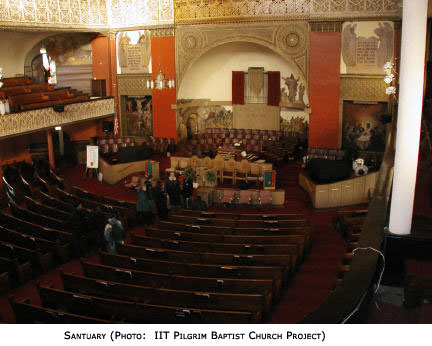 The sanctuary seated 1,500 in a spacious main floor and a gallery that Adler was determined to keep free of the kind of vision-obstructing cast iron columns that supported it below. To make this possible, the walls of the clerestory above were borne on huge wood trusses that stretched all the way to the corners. Over time, they began to sag, and eventually additional support had to be added. The sanctuary was richly polychromatic, the barrel vault covered in handsome oak. There was a profusion of Sullivan's distinctive, intricate ornament, executed in both terra cotta and plaster, incorporating the Star of David amidst his intricately rendered foliage.
The sanctuary seated 1,500 in a spacious main floor and a gallery that Adler was determined to keep free of the kind of vision-obstructing cast iron columns that supported it below. To make this possible, the walls of the clerestory above were borne on huge wood trusses that stretched all the way to the corners. Over time, they began to sag, and eventually additional support had to be added. The sanctuary was richly polychromatic, the barrel vault covered in handsome oak. There was a profusion of Sullivan's distinctive, intricate ornament, executed in both terra cotta and plaster, incorporating the Star of David amidst his intricately rendered foliage.
The building's life as a synagogue was short. By the 1920's, the community was in the midst of another major influx - what would come to be known as the Great Migration, the exodus of blacks from the rural south to northern cities like Chicago. The area was being transformed into Bronzeville, which, according to an Illinois Institute of Technology oral history project, was the “cultural, social, political and economic center of Black Chicago.” In 1915, the Pilgrim Baptist Church was founded, and in 1922, K.A.M. was acquired and transformed into a church with soon numbered over 7,000 worshippers.
In 1932, a former blues singer named Thomas A. Dorsey was hired as Pilgrim Baptist's choral director, and under Dorsey's direction, Pilgrim Baptist became the place where Gospel Music was born. In 1937, 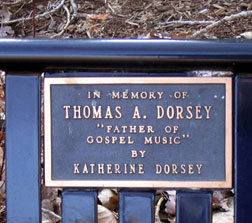 he became the advisor and accompanist to a young Mahalia Jackson, who sang in the church's choir, and who made the Father of Gospel's "Precious Lord Take My Hand" one of her most requested songs.
he became the advisor and accompanist to a young Mahalia Jackson, who sang in the church's choir, and who made the Father of Gospel's "Precious Lord Take My Hand" one of her most requested songs.
By the 1950's, Bronzeville was entering a steep decline. An eight-block swath of buildings was reduced to rubble for the construction of a new IIT campus. Middle-class blacks began moving out, and by 2001 Pilgrim Baptist's congregation had shrank to less than 500 parishioners. Recently, however, Bronzeville has undergone a renaissance. In 2003, the first new buildings opened on the IIT campus in almost four decades. All but one of the notoriously troubled public housing high-rises of Stateway Gardens have been demolished in favor of low-rise, "mixed income" development. There's new construction all throughout Bronzeville, including on Indiana, up and down from Pilgrim Baptist. The church had just raised funds for a $500,000 renovation.
That renovation may prove to have been the seed of the church's destruction. Early speculation 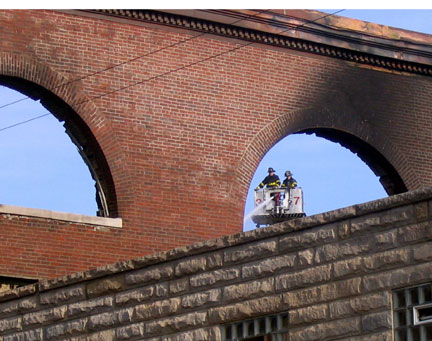 points to the fire being started by a blowtorch used by a worker repairing the roof. An errant spark, and a century of history was gone. The handsome wood became so much tinder. Spectacular orange flames lit up winter's early darkness. Adler's great wooden trusses weakened, buckled and collapsed, sending the blazing clerestory down to spread the fire throughout the sanctuary.
points to the fire being started by a blowtorch used by a worker repairing the roof. An errant spark, and a century of history was gone. The handsome wood became so much tinder. Spectacular orange flames lit up winter's early darkness. Adler's great wooden trusses weakened, buckled and collapsed, sending the blazing clerestory down to spread the fire throughout the sanctuary.
The next morning, the first sunny morning the city had seen in weeks, revealed the damage in full. Pilgrim Baptist has been left an empty shell. Sullivan's great walls still stand, but encase nothing but charred rubble, piled up forlornly in the sanctuary, now open to the sky. The gaping emptiness of the large arched windows make the walls seem like part of a Roman aqueduct. Strips of deformed copper, just applied for the renovation, drape over a fence or hang down from the roof like limp, twisted rags. Yellow police tape cordons off the site as if it were a crime scene. People come to a stop beside the charred remains and stare sadly, shaking their heads.
Parishioners face the loss bravely. One women reminded a TV interviewer that the sole of a church is not in a building, but in its spirit. A prayer breakfast brought talk of rebuilding. Although they still 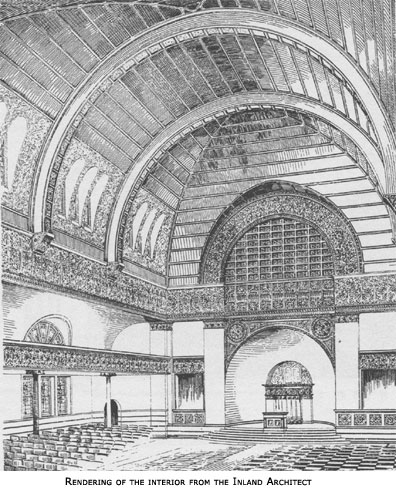 stand, it's still to be determined if the church's walls are structurally sound.
stand, it's still to be determined if the church's walls are structurally sound.
Architecture is built for use. For that reason, the problem of architectural preservation is often one of utility, of finding new uses that will give a historic building a reason, beyond aesthetics, to continue to exist. Pilgrim Baptist was that rare building that managed the transition on its own, finding ways to keep itself relevant down through the decades. In the process, it became a storehouse of human experience.
It was the here that Dankmar Adler built a synagogue for his father's congregation and it was here, in the spring of 1900, that Louis Sullivan helped bear the coffin of his estranged partner into the sanctuary they had designed together at the height of their success. Boxing legend Jack Johnson also had his funeral here. A teen-aged Mavis Staples sang here. Martin Luther King, Jr. preached here at the height of the struggle for civil rights. Pilgrim Baptist was the crossing where history, worship and architecture converged.
Mies van der Rohe talked of creating an architecture that was an expression of his time. So did Sullivan. But an architecture that endures - as K.A.M./Pilgrim Baptist Church endured, for over a century - can create something even more valuable: it can become a temple to the persistence of memory, a link to those who have gone before, transcending personal death to create a continuity of shared experience of what it is to be alive.
“How amiable are thy tabernacles, O Lord of hosts! ”
-Psalm 84:1, in Brahm's German Requiem
February 17, 2006 Postscript: As reported in the Chicago Tribune, the engineering firm of Wiss, Janney, Elstner Associates, Inc. have found after a study that the exterior walls of the church appear to be structurally sound, and recommend that they be braced to maintain that status until a such time as a decision is reached on the church's possible reconstruction.
Join a discussion on this story.
View Additional Images of K.A.M./Pilgrim Baptist Church.
© Copyright 2005 Lynn Becker All rights reserved.
